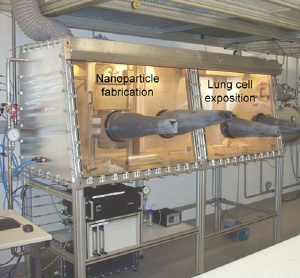Apr 12 2009
Cerium oxide is a ceramic nano-abrasive. Scientists have now examined, under conditions close to reality, what happens when it is breathed in and deposited on the lung surface. Initially, the result was rather reassuring.
 Cell cultures of lung epithelial cells (in the right-hand box) were exposed to an aerosol of cerium oxide nanoparticles in a special glove box. During the exposure of the cell cultures, the nanoparticles were freshly produced by flame synthesis in the left half of the box.
Cell cultures of lung epithelial cells (in the right-hand box) were exposed to an aerosol of cerium oxide nanoparticles in a special glove box. During the exposure of the cell cultures, the nanoparticles were freshly produced by flame synthesis in the left half of the box.
Synthetic nanoparticles are ubiquitous nowadays: either as an additive to building materials, whose properties they improve; in cosmetics, mainly in sun creams and toothpaste; or in foodstuffs, to thicken them or brighten their color. However, nano-safety research, i.e. knowledge of how nanoparticles interact with their environment and specifically with a living organism, is still largely in its infancy.
However, this is one of the central topics for the research group led by Wendelin Stark, Assistant Professor at the Institute for Chemical and Bio-engineering of ETH Zurich. The group carries out tests over and over again to investigate the effect nanoparticles have on their surroundings.
Conditions close to reality
Together with the research group led by Peter Gehr, Professor of Histology at the University of Bern, the scientists have now used a completely new method and a new type of lung cell culture to examine how cerium oxide nanoparticles act on the cells. The aim was to study the toxicity of cerium oxide, which is used in large amounts as an abrasive, mainly in the manufacture of semiconductor chips. Although, as a rule, this takes place in a hermetically sealed room from which people are excluded, the researchers now simulated a situation in which ceramic nanomaterial is inhaled directly, for example if nanoparticles are manufactured without protection or the powder is handled incorrectly.
The researchers did this by using what is called flame spray synthesis to spray cerium oxide nanoparticles in a closed glove box, thus simulating aerosols. A fan distributed the aerosols uniformly in the box, about 2.5 cubic meters in size, in which the aerosols were sprayed on to the cultured lung cells for ten, twenty and thirty minutes. The ETH researches hit upon the idea when they spoke to Barbara Rothen-Rutishauser, a scientist from Bern and first author of the paper. She told them about the new type of cell culture. The results of the interdisciplinary collaboration were published on-line in "Environmental Science and Technology".
The innovative aspect of the method is the special cell culture combined with the use of flame spray synthesis. The cell culture of lung epithelial cells grows on a permeable membrane. The lower surface of the epithelial cells is immersed in a medium and their upper surface is covered with a natural liquid layer. Thus the cell culture is very similar to the surface of the lung. As a result of the aerosol production, the spray process is also close to reality. The combination of these two techniques showed how inhaled nanoparticles are deposited on the lung surface. In conventional methods for such experiments up to now, cell cultures were bathed in nanoparticle solutions. However, this can cause the nanoparticles to agglomerate, which alters their properties; moreover, the lung surface is wet in a different way. Consequently, the behavior of the cells might also change.
No cell death
The scientists chose cerium oxide for their study, mainly because the material does not occur physiologically in cells, meaning that only the effect of the nanoparticle on the cell is observed. The longer the cultures were sprayed for, the more nanoparticles were deposited on the lung cells. The scientists observed that the cells were not destroyed, i.e. they did not die. However, the permeability of the cell layer increased. Therefore, the researchers suspect that certain structures of particular proteins that seal the interstices between the epithelial cells had altered under the influence of the nanoparticles. The production of a substance in the cell which is associated with oxidative stress and which could result in DNA damage could also be observed.
Long-term effects unknown
Robert Grass, group leader in Wendelin Stark's group, explains: "However, we were unable to observe the effect of the particles on the cells over a prolonged time." This is because the cultures must be subjected to further processing to allow them to be examined under a microscope. In a next step, the researchers plan to replicate even more realistic conditions by using what are known as triple cell co-cultures that simulate human cellular respiratory tract barriers. For example, they want to find out how the body's phagocytes and "waste disposal agents", known as macrophages, deal with nanoparticles.
Author: Simone Ulmer
Literature reference
Rothen-Rutishauser B, Grass RN, Blank F, Limbach LK, Mühlfeld C, Brandenberger C, Raemy DO, Gehr P & Stark WJ: Direct Combination of Nanoparticle Fabrication and Exposure to Lung Cell Cultures in a Closed Setup as a Method To Simulate Accidental Nanoparticle Exposure of Humans, Environ. Sci. Technol., On-line publication 2 March 2009 DOI: 10.1021/es8029347